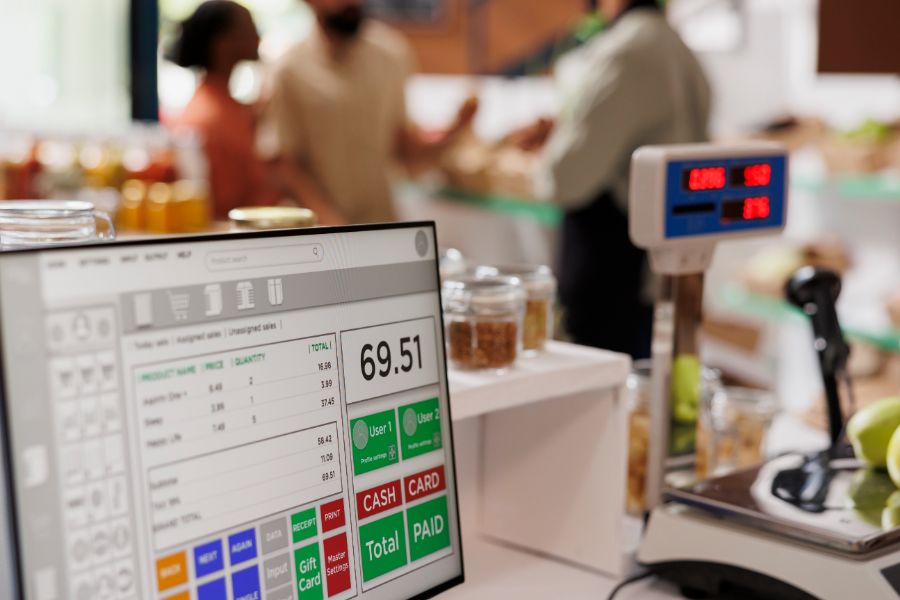The adoption of electronic point of sale (or EPOS) software has become increasingly prevalent, reshaping how businesses operate. Understanding the nuances of EPOS systems is pivotal for retailers seeking to optimize their operations. This essay delves into the pros and cons of electronic point of sale software for retail stores, highlighting key considerations and implications. By examining the advantages and drawbacks, retailers can make informed decisions regarding the implementation of EPOS solutions tailored to their specific needs.
How EPOS systems revolutionize retail operations
Electronic point of sale systems have brought about a significant transformation in the way retail operations are conducted, streamlining processes and enhancing efficiency. Let’s delve into how EPOS systems revolutionize retail operations, supported by compelling statistics:
- Increased retail revenue: Studies have shown that businesses using EPOS systems experience an average revenue increase of 20%. By providing faster transactions, reducing errors, and enabling better inventory management, EPOS systems contribute directly to revenue growth.
- Reduced transaction times: According to recent data, retail transactions using EPOS systems are completed 25% faster than those using traditional POS methods. The streamlined checkout process facilitated by EPOS systems translates into shorter wait times for customers, leading to higher satisfaction levels and increased sales.
EPOS systems play a pivotal role in revolutionizing retail operations, driving revenue growth, and enhancing the overall customer experience.
Advantages of Electronic Point of Sale Software for Retail Stores
Electronic point of sale systems offer numerous benefits for retail operations, ranging from eliminating human error to providing valuable insights into business performance. Here are some key advantages of EPOS systems:
- Elimination of human error
EPOS systems automate various processes, reducing the likelihood of human error in tasks such as manual data entry, pricing, and inventory management. By minimizing errors, EPOS systems ensure greater accuracy in transactions and inventory records, leading to improved operational efficiency and customer satisfaction.
- Improvement of customer experience
EPOS systems enhance the overall customer experience by processing transactions faster, providing personalized interactions, and offering efficient service. By reducing wait times at checkout and offering convenient payment options, they contribute to higher customer satisfaction levels and increased loyalty.
- Boost in efficiency
EPOS systems streamline workflows and automate repetitive tasks, leading to a significant boost in operational efficiency. By reducing the time spent on manual processes, such as inventory counting and order processing, EPOS systems enable retailers to serve more customers in less time, thereby increasing productivity and revenue.
- Provision of valuable insights and data
EPOS systems capture transactional data in real-time, providing retailers with valuable insights into sales trends, inventory levels, and customer preferences. By analyzing this data, retailers can make informed decisions regarding product offerings, pricing strategies, and marketing campaigns, ultimately driving business growth and profitability.
- Centralized database
EPOS systems centralize data storage, creating a single source of truth for all business information. By maintaining a centralized database of products, customers, and transactions, EPOS systems ensure consistency and accuracy across all store locations. This centralized approach simplifies inventory management, reporting, and decision-making processes, facilitating smoother operations and greater scalability.
Disadvantages of Electronic Point of Sale Software for Retail Stores
While electronic point of sale systems offer numerous benefits, there are also some disadvantages that retailers should consider:
- Higher initial cost
One significant drawback of implementing EPOS systems is the higher initial cost compared to traditional POS solutions. The investment in hardware, software licenses, and implementation can be substantial, particularly for small businesses with limited budgets. Additionally, there may be ongoing expenses for maintenance, updates, and technical support, adding to the overall cost of ownership.
- Training and learning curve for employees
Transitioning to EPOS systems often requires training for employees, which can be time-consuming and disruptive to daily operations. Staff members need to learn how to operate the new system, navigate the user interface, process transactions, and troubleshoot common issues. The learning curve may vary depending on the complexity of the EPOS system and the technical proficiency of the employees. Resistance to change or reluctance to adopt new technology may further prolong the training process and hinder employee productivity.
Selecting and Optimizing Electronic Point of Sale Systems for Retail Success
Choosing the right Electronic Point of Sale (EPOS) system and supplier is crucial for enhancing retail operations, improving customer experiences, and ensuring scalability and security.
You can follow these steps to mitigate potential disadvantages while selecting the most suitable EPOS system and supplier.
Step 1: Comprehensive Research and Evaluation
Start by thoroughly assessing the functionality and scalability of various EPOS systems. It’s important to ensure that the system can handle your current needs and is capable of scaling up as your business grows. This includes the ability to integrate additional features such as loyalty programs or e-commerce capabilities.
Evaluate the ease of use and compatibility with your existing hardware and software to facilitate a smooth transition and operation. Consider the total cost of ownership, which includes not just the purchase price but also ongoing maintenance, upgrades, and support costs.
Lastly, verify the provider’s credentials by researching their market history, reading customer testimonials, and reviewing case studies to gauge reliability and effectiveness.
Step 2: Customization and Flexibility
Ensure that the EPOS system offers the flexibility to be customized to your specific business needs. This includes having configurable options that cater to unique operational requirements and the ability to adapt to business changes or growth without requiring a complete system overhaul.
Customizable features should support specific processes unique to your business, such as special promotions, variable pricing, or handling unique product categories.
Step 3: Training and Support
Collaborate with your EPOS provider to develop customized training programs. These should address the specific uses of the system within your operations, including handling day-to-day transactions, managing inventory, and generating reports. Such targeted training ensures that all users are proficient and can fully leverage the system’s capabilities.
Simultaneously, confirm that comprehensive ongoing support is available from the provider. This includes troubleshooting, regular updates, and direct helplines, which are crucial for resolving issues quickly and minimizing downtime. Effective support ensures operational continuity and enhances user confidence, maintaining system efficiency.
Step 4: Choosing the Right EPOS Supplier
In selecting a supplier, consider their reputation and experience in the retail sector. A supplier with a solid track record and extensive industry experience is likely to offer more reliable systems and better support. The system should also integrate smoothly with existing business management software, such as CRM systems, accounting software, and e-commerce platforms. Prioritize data security and ensure the system complies with applicable regulations, using robust security measures to protect sensitive information. Review the customer support and service level agreements (SLAs) in detail to understand the scope of support, including response times and resolution guarantees.
By following this detailed approach, retailers can make informed decisions when selecting and implementing an EPOS system, ensuring it enhances operational efficiency, improves customer experiences, and supports business growth.
ConnectPOS illustrates an exemplary choice for retailers, offering customizable and scalable EPOS solutions that integrate seamlessly with other retail management systems. It provides strong security features to protect customer and transaction data, backed by comprehensive customer support, making it a top choice for modern retail operations.
FAQs (frequently asked questions) about electronic point-of-sale software retail stores
- What exactly is electronic point of sale (EPOS) software, and how does it differ from traditional POS systems?
Electronic point of sale (EPOS) software is a digital solution used by retail stores to facilitate transactions, manage inventory, and track sales data. Unlike traditional POS systems, which typically rely on on-premise hardware and software, EPOS software operates on cloud-based platforms, offering greater flexibility, scalability, and accessibility. EPOS systems also often include advanced features such as real-time reporting, integrated analytics, and omnichannel capabilities, enabling retailers to optimize operations and enhance the customer experience.
- How can electronic point of sale software benefit retail stores in terms of operational efficiency and customer experience?
Electronic point of sale software offers several benefits for retail stores:
- Operational efficiency: EPOS software automates repetitive tasks, such as inventory management, order processing, and transaction tracking, saving time and reducing errors. By streamlining workflows and providing real-time insights, EPOS software improves operational efficiency and productivity.
- Customer experience: EPOS software enhances the overall customer experience with features such as faster checkout, personalized promotions, and integrated loyalty programs. By offering convenient payment options, personalized recommendations, and seamless omnichannel experiences, retailers can increase customer satisfaction and loyalty.
- What are the potential drawbacks or limitations of implementing electronic point of sale software in a retail environment?
While electronic point of sale software offers numerous benefits, there are some potential drawbacks to consider:
- Higher initial cost: implementing EPOS software may require an initial investment in hardware, software licenses, and training, which can be costly for small businesses with limited budgets.
- Learning curve: Transitioning to EPOS software may require staff training and adjustment periods, which can temporarily decrease productivity and efficiency.
- Dependence on internet connection: cloud-based EPOS systems rely on a stable internet connection, which may POSe challenges in areas with unreliable connectivity or during network outages.
- How can retail store owners determine if electronic point of sale software is the right solution for their business needs and objectives?
Retail store owners should consider several factors when evaluating whether EPOS software is suitable for their business:
- Business goals: determine whether EPOS software aligns with your business goals and objectives, such as increasing sales, improving efficiency, or enhancing the customer experience.
- Scalability: assess whether the EPOS system can scale with your business as it grows and evolves, accommodating additional stores, products, and features.
- Budget and resources: evaluate the costs associated with implementing and maintaining EPOS software, including hardware, software licenses, training, and ongoing support.
- Customer needs: consider the needs and preferences of your customers, such as their preferred payment methods, shopping habits, and expectations for convenience and personalization.
Conclusion
Understanding the advantages and challenges of electronic point of sale software for retail stores is crucial for making well-informed decisions in the retail sector. EPOS systems can significantly enhance operational efficiency and elevate the customer experience, but they are not without their limitations, such as the need for initial investment and ongoing maintenance.
ConnectPOS exemplifies an excellent choice in EPOS technology, offering customized solutions specifically designed to meet the diverse needs of retailers. If you have any questions about ConnectPOS or are interested in a demo, please feel free to contact us.



